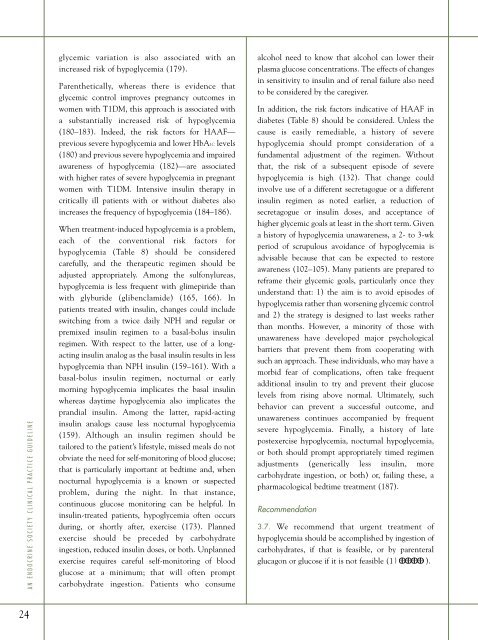Evaluation & Management of Adult Hypoglycemic Disorders
Evaluation & Management of Adult Hypoglycemic Disorders
Evaluation & Management of Adult Hypoglycemic Disorders
Create successful ePaper yourself
Turn your PDF publications into a flip-book with our unique Google optimized e-Paper software.
AN ENDOCRINE SOCIETY CLINICAL PRACTICE GUIDELINE<br />
24<br />
glycemic variation is also associated with an<br />
increased risk <strong>of</strong> hypoglycemia (179).<br />
Parenthetically, whereas there is evidence that<br />
glycemic control improves pregnancy outcomes in<br />
women with T1DM, this approach is associated with<br />
a substantially increased risk <strong>of</strong> hypoglycemia<br />
(180–183). Indeed, the risk factors for HAAF—<br />
previous severe hypoglycemia and lower HbA1C levels<br />
(180) and previous severe hypoglycemia and impaired<br />
awareness <strong>of</strong> hypoglycemia (182)—are associated<br />
with higher rates <strong>of</strong> severe hypoglycemia in pregnant<br />
women with T1DM. Intensive insulin therapy in<br />
critically ill patients with or without diabetes also<br />
increases the frequency <strong>of</strong> hypoglycemia (184–186).<br />
When treatment-induced hypoglycemia is a problem,<br />
each <strong>of</strong> the conventional risk factors for<br />
hypoglycemia (Table 8) should be considered<br />
carefully, and the therapeutic regimen should be<br />
adjusted appropriately. Among the sulfonylureas,<br />
hypoglycemia is less frequent with glimepiride than<br />
with glyburide (glibenclamide) (165, 166). In<br />
patients treated with insulin, changes could include<br />
switching from a twice daily NPH and regular or<br />
premixed insulin regimen to a basal-bolus insulin<br />
regimen. With respect to the latter, use <strong>of</strong> a longacting<br />
insulin analog as the basal insulin results in less<br />
hypoglycemia than NPH insulin (159–161). With a<br />
basal-bolus insulin regimen, nocturnal or early<br />
morning hypoglycemia implicates the basal insulin<br />
whereas daytime hypoglycemia also implicates the<br />
prandial insulin. Among the latter, rapid-acting<br />
insulin analogs cause less nocturnal hypoglycemia<br />
(159). Although an insulin regimen should be<br />
tailored to the patient’s lifestyle, missed meals do not<br />
obviate the need for self-monitoring <strong>of</strong> blood glucose;<br />
that is particularly important at bedtime and, when<br />
nocturnal hypoglycemia is a known or suspected<br />
problem, during the night. In that instance,<br />
continuous glucose monitoring can be helpful. In<br />
insulin-treated patients, hypoglycemia <strong>of</strong>ten occurs<br />
during, or shortly after, exercise (173). Planned<br />
exercise should be preceded by carbohydrate<br />
ingestion, reduced insulin doses, or both. Unplanned<br />
exercise requires careful self-monitoring <strong>of</strong> blood<br />
glucose at a minimum; that will <strong>of</strong>ten prompt<br />
carbohydrate ingestion. Patients who consume<br />
alcohol need to know that alcohol can lower their<br />
plasma glucose concentrations. The effects <strong>of</strong> changes<br />
in sensitivity to insulin and <strong>of</strong> renal failure also need<br />
to be considered by the caregiver.<br />
In addition, the risk factors indicative <strong>of</strong> HAAF in<br />
diabetes (Table 8) should be considered. Unless the<br />
cause is easily remediable, a history <strong>of</strong> severe<br />
hypoglycemia should prompt consideration <strong>of</strong> a<br />
fundamental adjustment <strong>of</strong> the regimen. Without<br />
that, the risk <strong>of</strong> a subsequent episode <strong>of</strong> severe<br />
hypoglycemia is high (132). That change could<br />
involve use <strong>of</strong> a different secretagogue or a different<br />
insulin regimen as noted earlier, a reduction <strong>of</strong><br />
secretagogue or insulin doses, and acceptance <strong>of</strong><br />
higher glycemic goals at least in the short term. Given<br />
a history <strong>of</strong> hypoglycemia unawareness, a 2- to 3-wk<br />
period <strong>of</strong> scrupulous avoidance <strong>of</strong> hypoglycemia is<br />
advisable because that can be expected to restore<br />
awareness (102–105). Many patients are prepared to<br />
reframe their glycemic goals, particularly once they<br />
understand that: 1) the aim is to avoid episodes <strong>of</strong><br />
hypoglycemia rather than worsening glycemic control<br />
and 2) the strategy is designed to last weeks rather<br />
than months. However, a minority <strong>of</strong> those with<br />
unawareness have developed major psychological<br />
barriers that prevent them from cooperating with<br />
such an approach. These individuals, who may have a<br />
morbid fear <strong>of</strong> complications, <strong>of</strong>ten take frequent<br />
additional insulin to try and prevent their glucose<br />
levels from rising above normal. Ultimately, such<br />
behavior can prevent a successful outcome, and<br />
unawareness continues accompanied by frequent<br />
severe hypoglycemia. Finally, a history <strong>of</strong> late<br />
postexercise hypoglycemia, nocturnal hypoglycemia,<br />
or both should prompt appropriately timed regimen<br />
adjustments (generically less insulin, more<br />
carbohydrate ingestion, or both) or, failing these, a<br />
pharmacological bedtime treatment (187).<br />
Recommendation<br />
3.7. We recommend that urgent treatment <strong>of</strong><br />
hypoglycemia should be accomplished by ingestion <strong>of</strong><br />
carbohydrates, if that is feasible, or by parenteral<br />
glucagon or glucose if it is not feasible (1| ).


